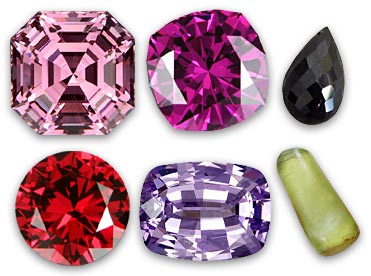Spinel
Spinel is the magnesium aluminium member of the larger spinel group of minerals. Some of the rarest gems in the world are spinels, even if many of them were once believed to be rubies or sapphires. For example, the enormous Black Prince’s Ruby that adorns the Imperial State Crown of the United Kingdom is actually a spinel, after a long history: Henry V even wore it on his battle helmet! The Timur ruby, a 361-carat red spinel now owned by Queen Elizabeth, has the names of some of the Mughal emperors who previously owned it engraved on its face: an undeniable pedigree!. But in fact all natural spinel are fairly rare, and that’s why they can be difficult to find in jewelry stores. It is also, paradoxically, why the prices for spinel are still reasonable.
In Burma (now known as Myanmar), where some of the most beautiful colours are mined, spinel was recognised as a separate gem species as early as 1587. In other countries the masquerade went on for hundreds of years. Spinels were most often referred to as ‘balas rubies’, which may have referred to their colour or their country of origin.
Natural spinel is a very fine gemstone indeed, with many characteristics that make it the near-equal of ruby and sapphire. Spinel is a magnesium aluminate, typically colored by chromium and iron and, occasionally, cobalt. It is very hard (8 on the Mohs scale, compared to 9 for ruby and sapphire), and it forms as a cubic crystal like a diamond. Spinel is a durable gemstone that is perfect for all jewellery uses. It is most often faceted in oval, round, or cushion shapes and is not currently found in calibrated sizes due to its rarity.
Spinel occurs in octahedral crystals but fortunately has very poor cleavage (unlike diamond, which has perfect cleavage). Due to spinel’s very good dispersion, gem spinels can possess vivid fire, and the intensity of spinel color is in part due to the fact that spinel is one of the few singly refractive gemstones (the others being garnet and diamond).
Recently some high quality African spinel has come on the market, with some pieces in good sizes. It has found some excellent spinel from Tanzania in red, pink, violet, and blue; and occasionally in unusual colors such as orange and purple. The supply of Burmese spinel is very limited but steady, and the material is generally of very high quality.
